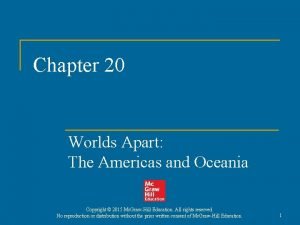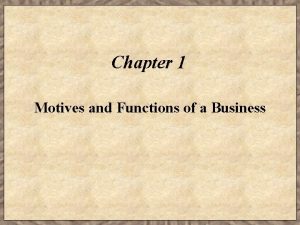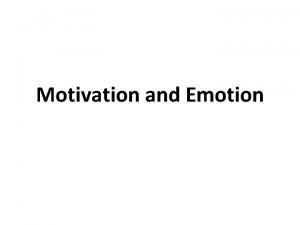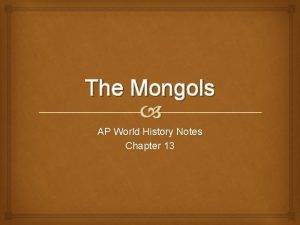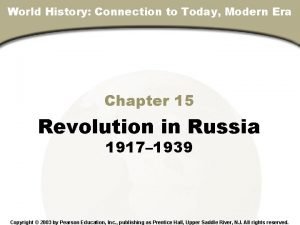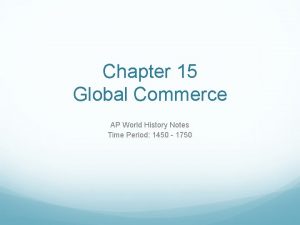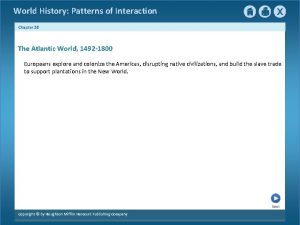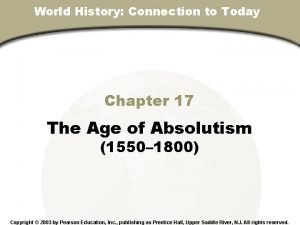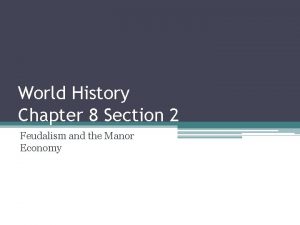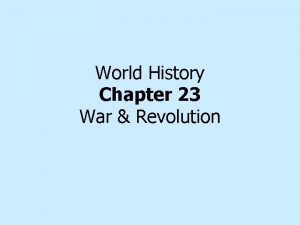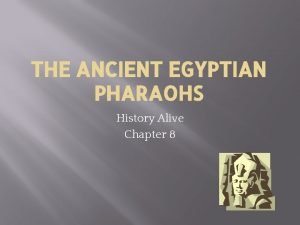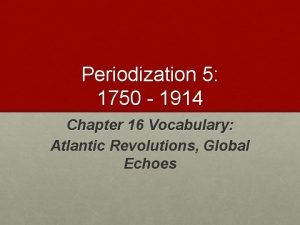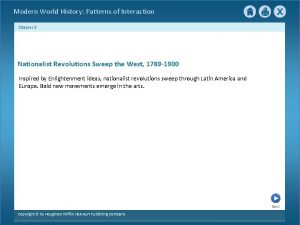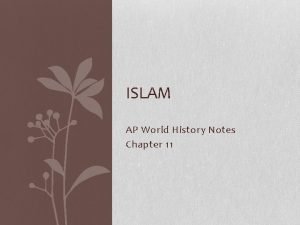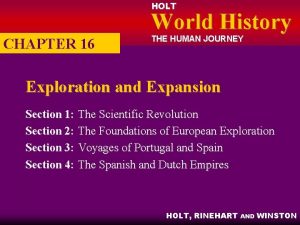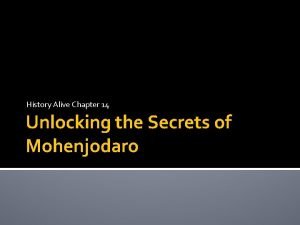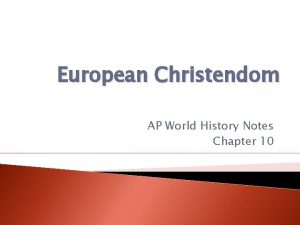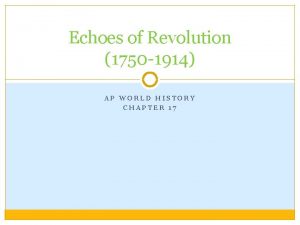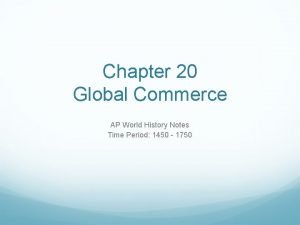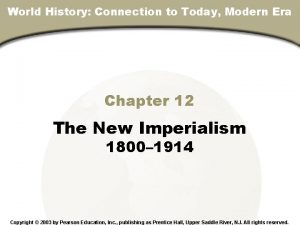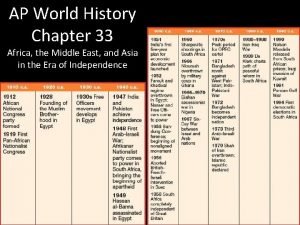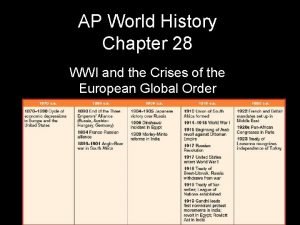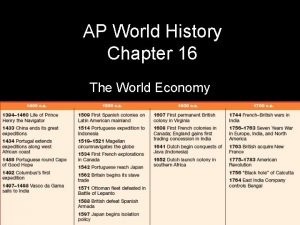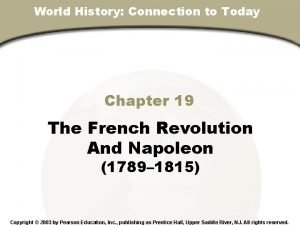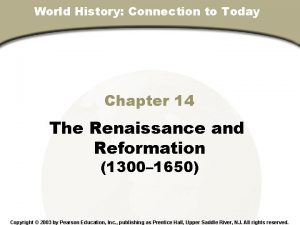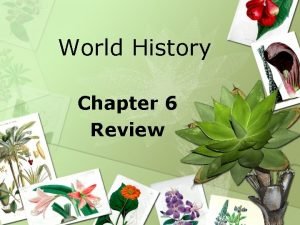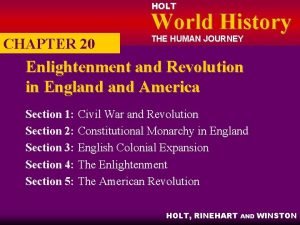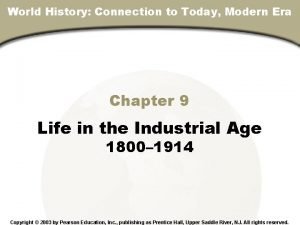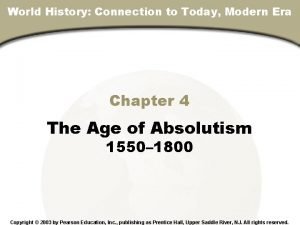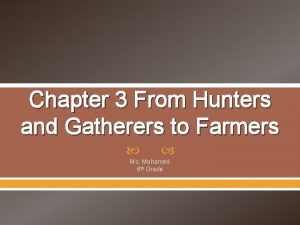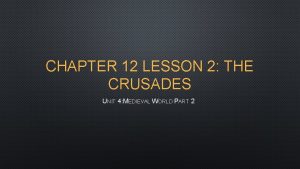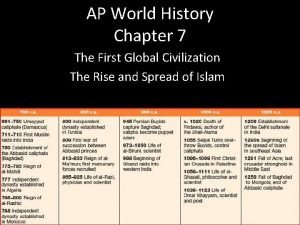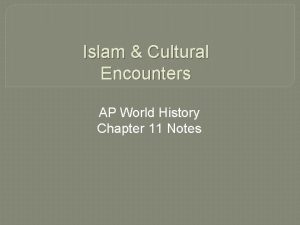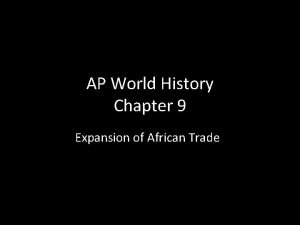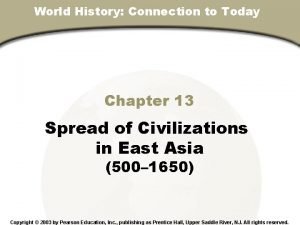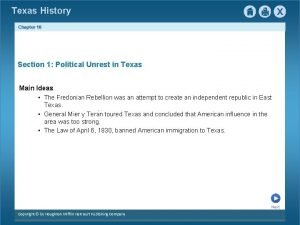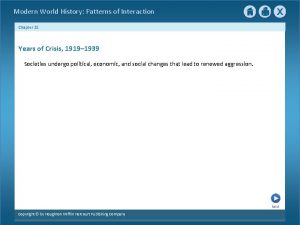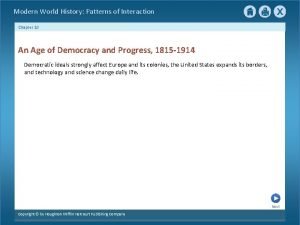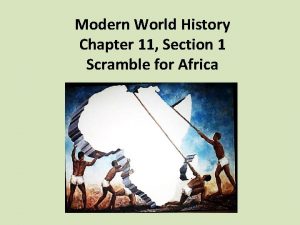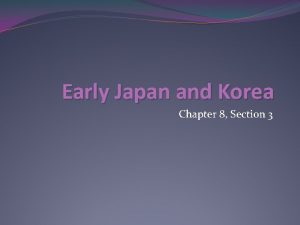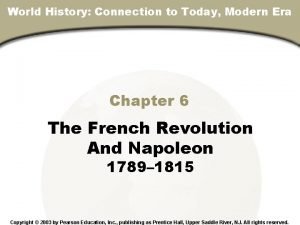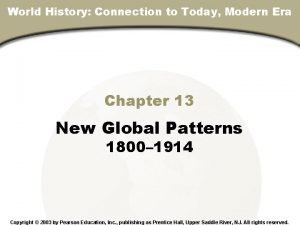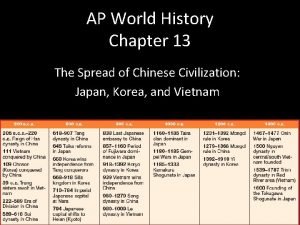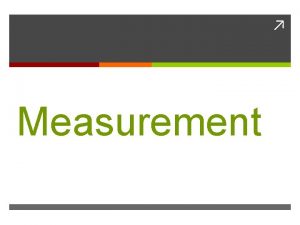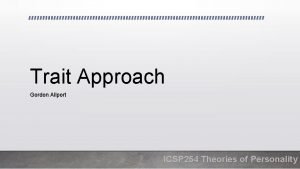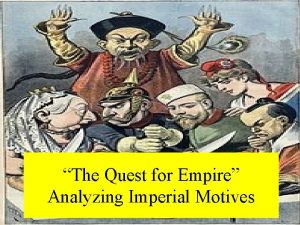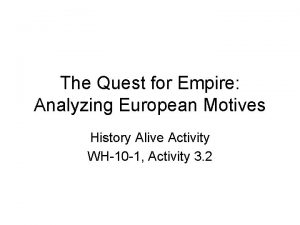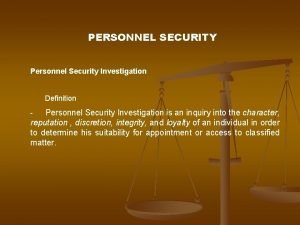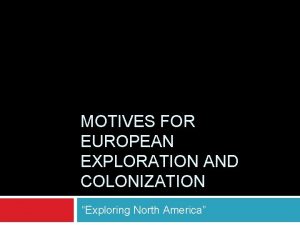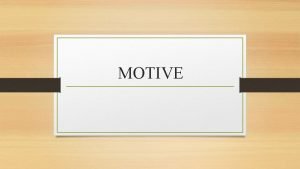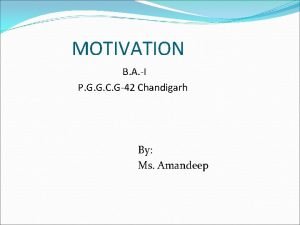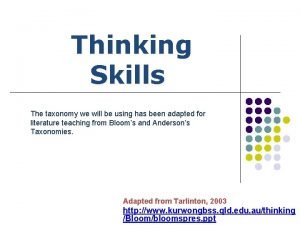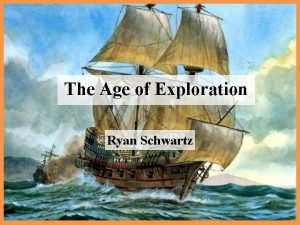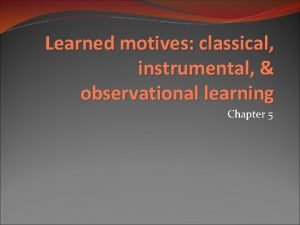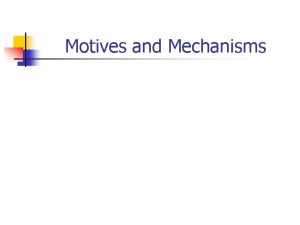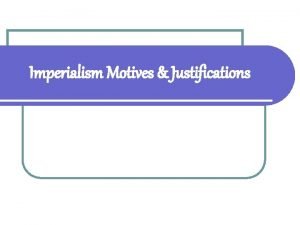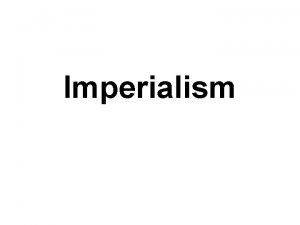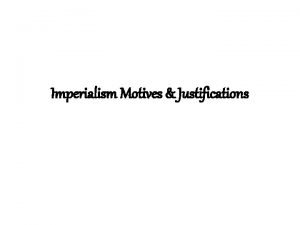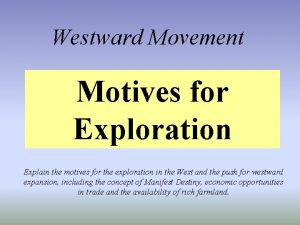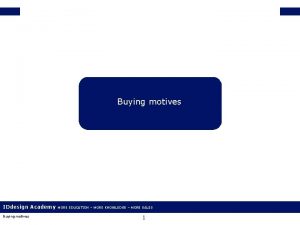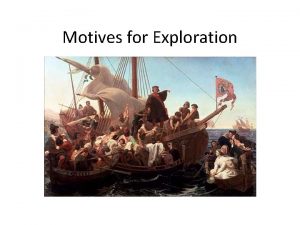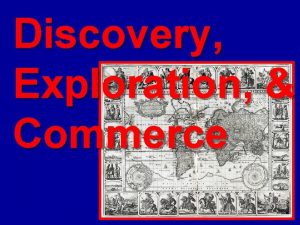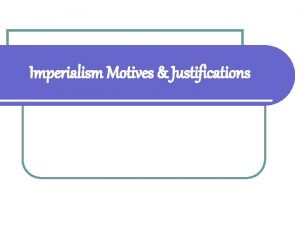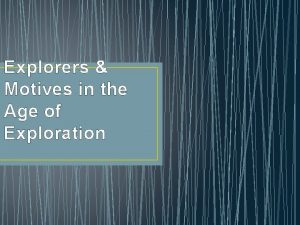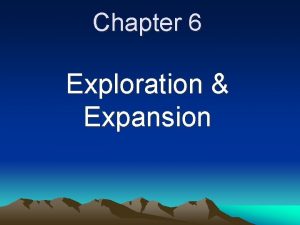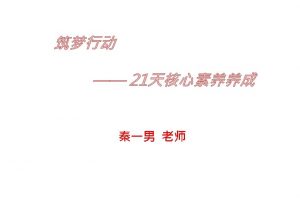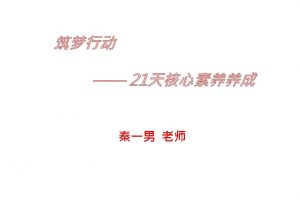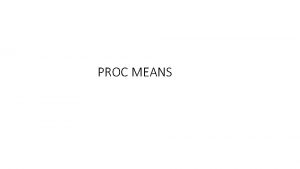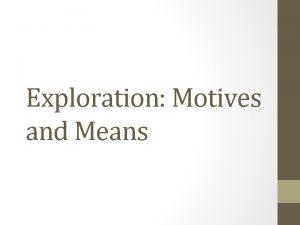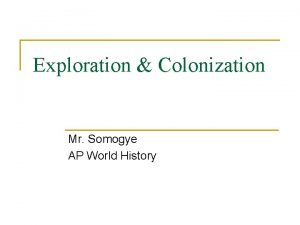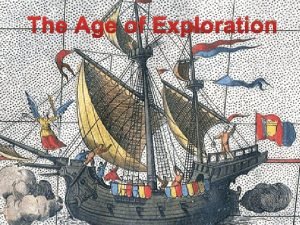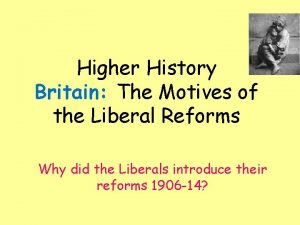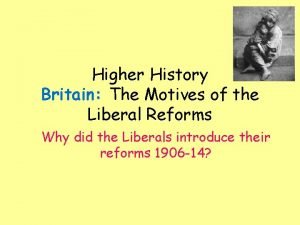Chapter 4 World History 8 MOTIVES AND MEANS



































































- Slides: 67

Chapter 4 World History

8 MOTIVES AND MEANS FOR EUROPEAN EXPLORATION 1. Europeans had been attracted to Asia. 2. Marco Polo had written accounts of the Far East. 3. Ottoman Turks reduced the ability of travel by land so Europeans wanted to gain access to Asia by sea. 4. Merchants wanted to expand trade. 5. They needed spices to preserve and flavor food. 6. The three chief motives were three G’s: God, Glory, and Gold. 7. European monarchies increased their power and resources to make voyages possible. 8. Technology enabled European explorers to make a series of voyages beyond Europe.

Prince Henry the Navigator (1394 -1460) • Portuguese prince who sponsored early voyages of discovery along the west coast of Africa. • The son of King John I, he established a court at Sagres (1419) composed of cartographers, navigators, shipbuilders, and seamen. • Under his direction the Portuguese caravel was developed, mapmaking was refined, and other advances important to voyages of discovery were made.

Prince Henry the Navigator (1394 -1460) • • Though he never sailed himself, Henry organized the expeditions that rediscovered the Madeira Islands (1418), and by degrees ranged southward along, but never quite rounded, the Horn of Africa. In 1441 his ship came back laden with gold dust and slaves, thus providing the means for financing further expeditions. To oversee the burgeoning slave trade, Henry built the first European trading post overseas (1448), a fort on Arguin Island off the Horn of Africa. Later, his captains rounded Cape Verde (1444) and voyaged down the coast as far as present-day Sierra Leone (1460). The voyages to Africa sponsored by Henry began the age of discovery, and laid the foundation for the Portuguese colonial empire. Prince Henry the Navigator

Bartholomeu Dias (1450? -1500) • The first European to see the stormy Cape of Good Hope at the southern tip of Africa. • He was one of the great Portuguese seamen who helped find the southeastern water route between Europe and Asia. Bartholomeu Dias

Bartholomeu Dias (1450? -1500) • As a youth Diaz entered the hazardous gold and ivory trade along the African Gold Coast and rose to the rank of captain. At this time the Italian cities were growing rich on their trade with India and the Far East. Portugal and other European nations were eager for a share of this trade. However, the Italians controlled the Mediterranean, which was the chief trade route to the East. The Portuguese dreamed of finding an all-water route around Africa. The groundwork was laid by Prince Henry, who had sent ships on voyages down the African coast (see Henry the Navigator). Exploration continued under his nephew, King John II. When Diogo Cam (or Cao) returned to Portugal with word that he had sailed past the mouth of the Congo River, John planned to send another expedition to sail even closer to the southern end of the continent. He chose Diaz to lead the venture. With two caravels and a storeship Diaz left Lisbon in August 1487. He sailed straight from Cape Palmas to the mouth of the Congo, then kept close to the coast until he reached Cabo da Volta (present-day Luderitz). About New Year's Day 1488 a gale hit his ships and blew them southward, past the southernmost tip of land. After 13 days he managed to turn east, but found no sheltering shore. Turning north, he sighted Mossel Bay, beyond the Cape of Good Hope. Unknowingly and out of sight of land, he had rounded the cape. Almost at the entrance to the Indian Ocean, Diaz' crew, weary and afraid, virtually forced him to turn back. On the return voyage he charted the southern waters, and in May 1488 he saw the Cape of Good Hope for the first time (see Cape of Good Hope). Diaz called it Cabo Tormentoso-"stormy cape. " Diaz was welcomed home in December 1488. The task that he began was completed ten years later by Vasco da Gama, who sailed around the Cape of Good Hope and on to India (see Gama). Diaz supervised the building of Da Gama's ships. In 1500 Diaz sailed as one of the captains in a large fleet headed by Pedro Alvares Cabral (see Cabral). Their destination was India, but they made a wide sweep into the South Atlantic and touched on the shores of Brazil. Then they headed southeastward and encountered fierce storms. Four ships went down, and all on board, including Diaz, were drowned.

Vasco da Gama (1460 -1524) • Portuguese navigator who first made the sea voyage from Europe to India. His voyage and the trade it opened up with India provided the foundation for the Portuguese Empire. Vasco da Gama

Vasco da Gama (1460 -1524) • • Chosen by King Manuel I to find a route to India, he sailed with four ships in 1497. He rounded the Cape of Good Hope (already explored by 1488) and after enduring both storms and mutinies he reached Calicut in India (1498). He subsequently commanded a fleet of 20 ships on a second voyage to India (1502 -03). This time he founded the Mozambique and Sofala colonies on the African coast and, after leading a naval attack, established Portuguese rule over Calicut. Sent to India as a viceroy in 1524, he died soon after his arrival.

Alfonso de Albuquerque (1453 -1515) • • Portuguese viceroy of the Indies (1506 -15), a principal founder of Portugal's empire in the East. As viceroy, he conquered Goa in India (1510) and made it a center of Portuguese power. He went on to conquer other eastern territories, including Ceylon and Melaka on the Malay Peninsula which was a thriving port for the spice trade. He twice took Ormuz (1507, 1515) to control the Arab spice trade. Alfonso de Albuquerque

Melaka • • Thriving port for the spice trade on the Malay Peninsula. It was important to the Portuguese to destroy Arab control of the region and it was also used as a weigh station. Melaka is the capital of Melaka, a state of Malaysia. Melaka lies on the southwest coast of the Malay Peninsula, 125 miles (201 kilometers) northwest of Singapore. Melaka lies in an area that produces pepper, rice, and sage. In the 1400 s, the city became the most important port in Southeast Asia. The Portuguese captured the city in 1511. The Dutch seized Melaka in 1641, and the British gained control of the city in 1824. Melaka is no longer a major Asian port.

• The Spanish established an overseas empire that was quite different from the Portuguese trading posts. • The Spanish had greater resources and a higher population.

Christopher Columbus (1451 -1506) • Genoese navigator in the service of Spain, credited with the discovery of America in 1492. It was not until 1492, however, that the Spanish monarchs Ferdinand Isabella agreed to support his venture. Christopher Columbus

Christopher Columbus (1451 -1506) • • He left Spain (August 3, 1492) with three ships, (the Santa Maria, Nina, and Pinta) and landed on the island of San Salvador in the Bahamas on October 12, 1492, just over two months later. Believing he had reached islands east of Japan, he briefly explored the Caribbean, including the coastline of Cuba and the island of Hispaniola, and then returned to Spain later in October. Christopher Columbus

Christopher Columbus (1451 -1506) • Three other voyages followed (1493, 1498, 1502), on which he discovered other Caribbean islands and reached the South American coast. Unable to adequately administer the Spanish colony in the New World he was removed as governor (1500), and died shortly after his disastrous fourth voyage (1502 -04). o At dawn on Aug. 3, 1492, the three ships hoisted anchor in the Palos harbor and got under way. Only three days out of Palos, the Pinta lost its rudder and the Nina's lateen rig proved unsuitable. Columbus had planned to stop at the Canary Islands only long enough to load fresh provisions and water, but he extended his stay to install a new rudder on the Pinta and square rigging on the Nina. On September 9 the three ships left the Canaries and spread their sails. Steady trade winds from the northeast drove them on their course due west. As they sailed westward, Columbus kept two records of progress. One was the distance he thought they had actually traveled. The other was a much shorter estimate that he showed the crew to quiet their fears at being so far from home. The false record was nearer to the actual mileage than the secret one. Columbus' mistakes were common to the times. His navigation instruments were crude, and, like most captains, he had little practice in their use. For the most part the passage was smooth and the winds were steady. As the days passed, however, the men could not see how they could sail home against winds that had blown them steadily west. About midway in the voyage the seamen noted that the compass varied to the west of true north. They were familiar with the easterly variation in the Mediterranean, but this change was new and fearful (see Compass, Magnetic). A falling meteor and the thick-growing plants of the Sargasso Sea increased their fears. On October 8 and 9 the men were ready to rebel. Columbus had to agree to turn back if land was not sighted within three days. On October 11 the Pinta fished up a piece of bamboo, a pole, a board, and a stick that seemed to have been shaped by tools. At 10 PM Columbus himself thought he saw lights. At 2 AM on October 12, Rodrigo de Triana, a seaman aboard the Pinta, cried loudly the first sight of the New World. The voyage from the Canaries had taken 33 days. o The little Spanish fleet had sailed among the Bahama Islands. Columbus named the first land sighted San Salvador (probably now Watling Island). Its Indian name was Guanahani. The ships' boats were put over the side and Columbus, accompanied by officers and crewmen, landed. With them they carried the royal banners of Ferdinand Isabella. They were met by a band of curious but peaceful natives. The Spaniards knelt on the sand gave thanks to God for the safe and successful voyage. Then, while the natives watched, Columbus took possession of the island in the name of the rulers of Spain. The crewmen, delighted with the rich and unexpected discovery of this island, begged Columbus' forgiveness for their disobedience. The natives were friendly and helpful. Columbus, believing San Salvador to be an island of the Indies, called them Indians. At once the men began trading with the Indians, offering hawks' bells and glass beads for the Indians' ornaments. Sailing on, Columbus stopped at islands he named Santa Maria de la Concepcion (now Rum Cay), Fernandina (Long Island), and Isabela (Crooked Island). He then sailed south to the north coast of Cuba. He named this island Juana. Everywhere he asked the Indians where gold could be found. On Dec. 6, 1492, he reached the north coast of Hispaniola. Previously he had found small trinkets of gold, but here the natives told of a gold mine in the interior of the island. Early Christmas morning the Santa Maria went aground off Cap Haitien. Before it could be worked off, its bottom was so badly torn that the ship had to be abandoned. From its timber Columbus built a small fort, La Navidad. The sailors, excited by stories of gold, begged to be left as colonists. Columbus selected 39 to stay.

Line of Demarcation • This line extended from north to south through the Atlantic Ocean and the easternmost part of the South American continent. Unexplored territories east of the line would be controlled by Portugal, and those west of the line by Spain. This was according to the Treaty of Tordesillas.

Line of Demarcation • • Line of Demarcation was an imaginary line drawn by Pope Alexander VI to settle land claims. The line was drawn in 1493, after Christopher Columbus returned from his first voyage to the Americas. The pope hoped it would prevent disputes between Spain and Portugal over new lands discovered by Spanish and Portuguese explorers. The line ran from north to south about 350 miles (563 kilometers) west of the Azores and Cape Verde Islands. It barely touched the east coast of the South American mainland, which had not yet been discovered by Europeans. Spain was permitted to claim land to the west of the line, and Portugal could claim land to the east of the line. Neither nation found this settlement satisfactory. So the next year Spain and Portugal moved the line west to a point about 1, 295 miles (2, 084 kilometers) west of the Cape Verde Islands, by the Treaty of Tordesillas. This agreement later supported Portugal's claim to territory that is now eastern Brazil. The line was never surveyed, so its exact location was not determined. Scholars think that it lay near the 48° west longitude line. A continuation of the Line of Demarcation around the globe and into the Eastern Hemisphere gave Portugal the right to claim the Philippine Islands. Spain recognized this claim in the Treaty of Saragossa in 1529, which set the line 17° east of the Moluccas (Spice Islands). In later treaties with Spain, Portugal gave up its claim to the Philippines and won the rest of Brazil. But Portugal and Spain could not secure all the newly discovered lands, because France, England, and the Netherlands ignored the Line of Demarcation and claimed territory for themselves.


John Cabot (1450 -1498) • • Italian navigator serving England. On a voyage of discovery (1497), he landed at what may have been Cape Breton Island explored the coastline of Nova Scotia and Newfoundland. Voyages of John Cabot

Amerigo Vespucci (1454 -1512) • • Italian navigator who explored some 6, 000 miles of the east coast of South America, including the mouths of the Amazon River (1499) and the Rio del la Plata (1500). Vespucci realized the New World was a new continent, instead of a part of Asia as had been thought. The name "America" is derived from his name. Vespucci also devised a method for figuring longitude with remarkable accuracy and calculated the earth's circumference to within 50 miles of its true measure. Amerigo Vespucci

Conquistadors • Spanish military adventurers who led the Spanish exploration and conquest of the New World.


Hernan Cortés (1485 -1547) • • Spanish conquistador who conquered Mexico and the Aztec Empire (1519 -1521). Spanish conquistador and conqueror of Mexico (1519 -21). He joined with D. Velazquez in conquering Cuba (1511), then led a military expedition into Mexico to conquer the Aztec empire of Montezuma for Spain. Setting out (1519) with 600 men and 16 horses, and ignoring Velazquez's orders that he return, he burned his eleven ships on arriving in Mexico, to prevent his men from retreating. Hernan Cortés

Hernan Cortés (1485 -1547) • After conquering Mayan tribes, he marched to the Aztec capital of Tenochtitlan (later Mexico City). Montezuma received Cortes, believing him to be the descendant of an Aztec god; Cortes immediately took him hostage. After traveling to the coast to defeat forces sent by Velazquez, Cortes returned to the capital to find the Aztecs in revolt. In a famous battle known as La Noche Triste ("The Sad Night, " 1520), Cortes suffered heavy casualties. Returning a year later, he conquered the city and, with it, the empire. He was, however, replaced (1526) as governor of New Spain. He died (1547) in Spain, disillusioned and embittered. Hernan Cortés

Francisco Pizarro (1476 -1541) • • Francisco Pizarro Spanish conquistador who conquered the Inca Empire in Peru (1531 -1533). He first went to the New World in 1509, and accompanied Vasco Nunez de Balboa when the latter sighted the Pacific Ocean (1513). With Diego de Almagro, he explored (152226) the west coast of South America, then returned to Spain (1528) to prepare for the conquest of Peru.

Francisco Pizarro (1476 -1541) • In 1531, with fewer than 200 men, he enticed the Inca chieftain Atahualpa into his hands by treachery, extracted an enormous ransom from him, and later had him executed (1533). He then captured the city of Cuzco, and the conquest of Peru was completed. Pizarro founded Lima (1535). In 1537 -38, he came into conflict with Almagro and his followers, and he ordered Almagro beheaded. Pizarro was later assassinated by Almagro's followers (1541). Francisco Pizarro

• • • Encomienda System for supplying Indian laborers in Spanish colonial America (16 th-18 th centuries). The encomienda (entrustment) specified that a Spanish settler would receive a certain number of Indian laborers, in return for which he would protect them and instruct them in Christianity. The system resulted in great hardships for the Indians despite attempts at reform (16 th century). Forced labor through the encomienda system, starvation, and especially disease took a toll on Native American lives. 80% of Native Americans died due to the arrival of Europeans.

Ferdinand Magellan (1480? -1521) • He led the first expedition that sailed around the world, though he died in route. • The first European to sail across the Pacific Ocean and the first to discover a route by which ships could sail a complete circle around the world, Ferdinand Magellan was the Portuguese navigator for whom the Strait of Magellan is named. Ferdinand Magellan

Ferdinand Magellan (1480? -1521) • The strait, located at the southern tip of South America, proved to be the long-sought connection between the Atlantic and Pacific oceans. Sailing for the Spanish king Charles I (later Holy Roman Emperor Charles V), Magellan showed in his explorations that the Earth is round. He also established a new route to the riches of the East, a route that involved sailing to the west.

Ferdinand Magellan (1480? -1521)

Ferdinand Magellan (1480? -1521) • • • Fernao de Magalhaes was born in about 1480, probably in Oporto, Portugal. (Ferdinand Magellan is the English spelling of his name. ) The son of a Portuguese nobleman, he served with distinction in the Indies and Morocco during his youth. He felt that he was not sufficiently rewarded for these services, and the Portuguese king advised him to offer his services elsewhere. He therefore gave up his nationality and offered his services to the ruler of Spain in 1517. The Portuguese claimed that all the islands of the Far East lay in the portion of the Earth assigned to Portugal by Pope Alexander VI (see America, Discovery and Colonization of). Magellan claimed that many of them, including the rich Spice Islands, or Moluccas, actually lay in Spain's territory. He said that the Portuguese maps had been falsified to conceal this fact. Magellan offered to use his knowledge of Portuguese secrets to prove his claim. He planned to reach the Spice Islands by sailing westward through a strait that he hoped to discover at the southern tip of America. The Spanish king finally accepted Magellan's proposal. On Aug. 10, 1519, Magellan set sail from Seville in command of five small vessels. He sailed across the Atlantic Ocean and down the coast of South America until cold weather and winter storms forced him to seek winter quarters. A mutiny was put down by force.

Ferdinand Magellan (1480? -1521) • • Sailing again in September of 1520 (spring in the Southern Hemisphere), Magellan's fleet rounded a promontory, and on October 21 he sighted what he guessed to be the sought-for strait. Two ships went ahead and reported that the strait led to an ocean beyond. The fleet proceeded. What they had thought to be the ocean, however, proved to be only a large bay in the strait. At a council with his navigators Magellan decided to go on. For more than a month he battled his way through the stormy 360 -mile (580 -kilometer) passage that now bears his name. One vessel was wrecked, and another sailed back to Spain. Neraztheless, Magellan insisted on going ahead. On November 28 he reached the ocean that Balboa had discovered seven years before. Because the ocean now looked so calm, Magellan named it the Pacific. At first the voyage on the Pacific went well. After a month of sailing, however, terrible hardships struck the fleet. The food ran low, and the sailors were reduced to eating the leather fittings of the ship. There was a scarcity of drinking water, and many of the crew died of scurvy. The fleet sailed about 100 days before arriving at the islands that are now called the Philippines. At Massava Magellan negotiated Spain's first alliance in the Pacific. At Cebu he converted the king and his chief followers to Christianity. Magellan sailed from Cebu to the neighboring island of Mactan. There he and his men became involved in a fight with the natives, and Magellan was killed on April 27, 1521. Under the leadership of Juan Sebastian del Cano, the sailors burned one of the three remaining vessels and sailed to the Spice Islands. Another ship started to leak and had to be abandoned. The last remaining vessel, the Victoria, commanded by Del Cano, set out for home. Leaky but laden with spices, the Victoria rounded the Cape of Good Hope and dropped anchor in the harbor of Seville on Sept. 9, 1522. After a voyage of slightly more than three years, it had circled the globe. Contrary to popular belief, Magellan succeeded in sailing around the world before his death. He did not encompass the globe on a single voyage, however. On a previous eastbound voyage to the East Indies, he had gone beyond the longitude of the Philippines. Thus, at the time he was killed, he had already overlapped his earlier course. In the history of discovery no name ranks higher than that of Magellan. He opened the Pacific Ocean to new exploration and trade. John Fiske, the American historian, says: "The voyage thus ended was doubtless the greatest feat of navigation that has ever been performed, and nothing can be imagined that would surpass it except a journey to some other planet. "

• Magellan’s voyage showed that ships could reach Asia by way of the Pacific Ocean. Spain claimed the route around the southern tip of South America. Other European countries hoped to find an easier and more direct route to the Pacific Ocean. If it existed, a northwest trade route through North America to Asia would become highly profitable. Not finding the route, the French, English, and Dutch instead established colonies in North America.

Juan Ponce de Léon (1460 -1521) • He was in search of the “fountain of youth” and landed in modern-day Florida in 1513 and claimed it for Spain. Juan Ponce de Léon

Juan Ponce de Léon (1460 -1521) • A Spanish soldier and explorer, Juan Ponce de Leon is probably best remembered for his search for the fabled Fountain of Youth. He was born in the province of Leon in northwestern Spain in 1460. In 1493 he accompanied Christopher Columbus on his second voyage to America. Ponce de Leon established a colony on Puerto Rico in 1508 and was made governor in 1509. In Puerto Rico he heard a legend about an island called Bimini, where there was said to be a spring that restored youth to all who bathed in it. It is said he was seeking this spring when he discovered Florida. • He sailed from Puerto Rico in March 1513. On Easter Sunday he sighted the coast. A few days later he landed on Florida's east coast, near what is now St. Augustine. He named the place La Florida after the Spanish term for Easter Sunday--Pascua florida, or "flowery feast. " He then sailed around the peninsula and up the west coast. He returned to Florida in 1521. Wounded during an Indian attack, he was taken back to Cuba, where he soon died. Ponce de Leon is buried in the cathedral at San Juan, Puerto Rico.

Francisco Vásquez de Coronado (1510 -1554) • In 1540 -1541 he led an expedition throughout much of present-day Arizona, New Mexico, Texas, Oklahoma, and Kansas. • He was in search of the “Seven Cities of Gold” in the American Southwest. Francisco Vásquez de Cornado

Francisco Vásquez de Coronado (1510 -1554) • • • One of the strangest journeys ever made in search of gold was led by the Spaniard Francisco Coronado. His army of several hundred Spaniards, Indians, and slaves was accompanied by herds of cattle, pigs, and sheep. Instead of the cities filled with treasure that he expected to find in the wilderness north of Mexico, Coronado found only poor Indian villages. He did, however, establish Spain's later claim to land that now covers a huge portion of the United States. The claim stretched from what is now California into Oklahoma and Kansas. Francisco Vazquez de Coronado was born to a noble family of Salamanca, Spain, in about 1510. As a young man at court he became friendly with Antonio de Mendoza, one of the king's favorites. Mendoza was appointed viceroy of New Spain (Mexico) in 1535, and Coronado went with him to America. In Mexico City Coronado married wealthy Beatriz Estrada. In 1538 Mendoza appointed Coronado governor of New Galicia, a province in western Mexico. Explorers brought back stories of the Seven Golden Cities of Cibola. Mendoza made Coronado the commander of an expedition to seize the treasure. Coronado led his party from Culiacan, a northern outpost of New Galicia, in April 1540. The expedition came upon the first of the promised seven cities in July. The golden cities of Cibola were actually the Indian pueblos of present-day Zuni in western New Mexico. From here Coronado sent out scouting parties. One discovered the Grand Canyon. Another found more pueblos in a fertile area of the Rio Grande Valley. Here the expedition spent the winter. New hope came when an Indian slave told of a new land to the northeast whose capital, Quivira, was very rich. With 30 men and the slave as guide, Coronado set forth. After months they found Quivira in what is now central Kansas. It held only Indian tepees. The slave confessed he had invented the story and was executed. Coronado returned to the Rio Grande. After spending a second winter in the pueblos, the expedition started homeward. The tattered army followed a route over deserts and mountains in blazing summer heat. In the fall of 1542 Coronado led only about 100 men into Mexico City. The remaining survivors trailed in during the next months. In 1544, during an official inquiry, Coronado was charged with corruption and negligence and removed as governor of New Galicia. He returned to Mexico City, where he retained his post as an alderman until he died on Sept. 22, 1554.

Columbian Exchange • The transatlantic trade of crops, technology, and culture between the Americas and Europe, Africa, and Asia that began in 1492 with Columbus’s voyage. More Information on Columbian Exchange

Giovanni da Verrazzano (1485 -1528) • an Italian in the service of France who looked for a waterway to the Pacific along the North American coast and discovered New York Harbor. Giovanni da Verrazzano

Giovanni da Verrazzano (1485 -1528) • After his education in Florence, Verrazzano moved to Dieppe, France, and entered that nation’s maritime service. He made several voyages to the Levant, and in 1523 he secured two ships for a voyage backed by the French king to discover a westward passage to Asia. In January 1524 he sailed one of those vessels, La Dauphine, to the New World and reached Cape Fear about the beginning of March. Verrazzano then sailed northward, exploring the eastern coast of North America. He made several discoveries on the voyage, including the sites of present-day New York Harbor, Block Island, and Narragansett Bay, and was the first European explorer to name newly discovered North American sites after persons and places in the Old World. • Verrazzano wrote interesting, though sometimes inaccurate, accounts of the lands and inhabitants that he encountered. His explorations concluded at the eastern part of Newfoundland. His return to France on July 8, 1524, gave King Francis I his nation’s claim to the New World. • Verrazzano undertook two more voyages to the Americas. In 1527 he commanded a fleet of ships on an expedition to Brazil that returned profitable dyewood to France. His final voyage began in the spring of 1528, when he sailed with his brother, Girolamo, from Dieppe with two or three ships. The fleet sailed to Florida, the Bahamas, and finally the Lesser Antilles. He anchored there off one of the islands (apparently Guadeloupe), went ashore, and was captured, killed, and eaten by cannibals.

Jacques Cartier (1491 -1557) • French explorer who in 1534 explored the St. Lawrence Seaway looking for a waterway to the Pacific Ocean. • He also claimed an island named Mont Real (Mount Royal) which later became Montreal. Jacques Cartier

Jacques Cartier (1491 -1557) • • • In the early 1500 s the French explorer Cartier tried to find a sea passage to the East Indies through North America. Instead he discovered the St. Lawrence River and opened Canada to European settlement. Jacques Cartier was born in St-Malo, France, on Dec. 31, 1491. Very little is known of his early life. On the first of his voyages to North America he set sail from St-Malo on April 20, 1534. On May 10 he reached northern Newfoundland. He passed through the Strait of Belle Isle and explored the Gulf of St. Lawrence. On May 16, 1535, Cartier sailed again from France. This time he had three vessels. He camped at a spot, far up the St. Lawrence, that the Indians called Stadacona, near the present site of Quebec. He took his smallest ship and two boats up the river to where it widens into Lake St. Peter. There his ship went aground on shoals. Cartier then continued his exploration in small boats and on foot. He reached the fortified Indian village of Hochelaga on an island where the Ottawa and St. Lawrence rivers meet. He gave the name Mont Real (Mount Royal) to the highest hill on the island (see Montreal). Cartier went up the river until stopped by the Lachine Rapids. He wintered at Stadacona, where 25 of his 110 men died of scurvy. In the spring, with 12 captured Indians, he returned to France. In 1541 he took colonists in five ships to Cap Rouge, near Quebec. He returned to France in 1542. The colony, under the sieur de Roberval, was a failure, and for the time being France lost interest in Canada. Cartier retired to St-Malo, where he served as an adviser on navigation. He died on Sept. 1, 1557.

Samuel de Champlain (1567 -1635) • French navigator and explorer who is called the “Father of New France. ” • He established fur trading settlements in Canada and founded Quebec in 1608. Samuel de Champlain

Samuel de Champlain (1567 -1635) • French navigator and explorer, called the "father of New France. " After earlier expeditions to Canada, Champlain founded the settlement of Port Royal in Nova Scotia (1605). In 1608, he founded the city of Quebec and, establishing a lucrative fur trade there, was named commandant of New France. Further explorations took Champlain as far west as Lakes Ontario and Huron and as far south as Massachusetts Bay. He also traveled to Lake Champlain, in New York, which is named for him. Champlain extended French claims to territory as far west as Wisconsin. In 1628, he defended Quebec from English privateers, surrendering his garrison only after running out of food and gunpowder. (The colony was restored to the French in 1632. ) Champlain made his last trip to Quebec in 1633, where he died of a stroke in 1635.

MARQUETTE & JOLIET Jacques Marquette (1637 -1675) Louis Joliet (1645 -1700) • French Jesuit priest who • French explorer who was a missionary on the first explored the Great Lakes European exploration of the and led the first European Mississippi River in 1673. expedition on the Mississippi River. Jacques Marquette Louis Joliet

René-Robert Cavelier sieur de La Salle (1643 -1687) • French explorer who in 1682 explored the lower Mississippi River all the way to the Gulf of Mexico. He named the area Louisiana in honor of the French king, Louis XIV. René-Robert Cavelier sieur de La Salle

NEW FRANCE • Name given to the French colonial empire in North America.

John Cabot (1450 -1498) • Italian who served in the service of England looked for a Pacific waterway along the North American coast. • He founded Newfoundland in 1497 and Nova Scotia and claimed the eastern coast of North America for Great Britain in 1498. John Cabot

John Cabot (1450 -1498) • In 1497 a tiny ship, the Matthew, sailed from Bristol, England, with a crew of 18 men on a historic voyage. The captain was John Cabot, an Italian born in Genoa. He had moved to England in about 1484 and was sailing under the flag of King Henry VII. Henry had refused to help Columbus when he was trying to fit out his expedition. Five years later he was delighted to give permission for Cabot's voyage. • Cabot was sure he could reach Asia by sailing westward. After several weeks, he sighted the coast of North America on June 24, 1497. The land he discovered was probably Cape Breton Island the nearby island of "New Found Land. " When Cabot returned with news of his discovery, the king gave him ten pounds and the rank of admiral. • The next year, 1498, Cabot set out on a second voyage with two ships and 300 men. He intended to sail down the coast he had already found. This he believed to be the extreme northeast of Asia. He thus hoped to find Japan. Instead he discovered the barren shores of Labrador, which he named. Afterward he sailed as far south as Maryland. There he abandoned his search for Japan because his supplies had run low. It is thought that he died in Bristol shortly after his return from this voyage. • Cabot was the first European to reach the shores of North America since the days of the old Norsemen. England later claimed the whole of North America on the ground that Cabot was the first discoverer to reach the mainland.

JAMESTOWN • The first permanent British settlement in North America. It was founded on May 14, 1607 and was located on the James River.

Pilgrims • A group of people who in 1620 founded the colony of Plymouth in Massachusetts to escape religious persecution in England.

Pilgrims • English religious Separatists, and other dissenters, who sailed aboard the Mayflower to Plymouth Rock (Dec. 21, 1620) and founded the first New England colony. Originally, the Separatists opposed the doctrines of the established Church of England founded an independent congregation. Around 1607 some of them emigrated to Holland to escape harassment and persecution. The experiment in Holland did not prove satisfactory, and the group then negotiated with a London stock company for a charter that would enable them to go to America. In Sept. , 1620, 102 passengers embarked on the Mayflower for the voyage. Some of the group, including J. Alden and M. Standish, were non-Separatists (called Strangers), hired to protect the stock company's interests. Before landing they signed the Mayflower Compact (q. v. ), which provided for a government by the will of the majority.

Puritans • A group of people who sought freedom from religious persecution in England by founding a colony at Massachusetts Bay in the early 1600’s.

• • • Puritans "I will make them conform or I will harry them out of the land. " This was the threat that King James I of England made to the Puritans when they asked him to "purify" the state church of England of certain ceremonies and usages derived from the Roman Catholic church, which they disliked. These Puritans were not dangerous revolutionists but plain citizens of England-farmers, merchants, professional men, and scholars--especially from the University of Cambridge. They came to be regarded as gloomy fanatics, and it was humorously said that "they objected to bear baiting, not because of the pain to the bear, but because of the pleasure to the spectators. " The Puritans of the time of James I, however, were not afraid of innocent pleasure. Many of them were fond of music; the Puritan country gentlemen hunted; and the writings of one of the foremost Puritans, John Milton, have come down as a priceless literary heritage. The Puritans were the advanced wing of the Protestants in England in the days of the Reformation. The division began among the religious exiles from England who sought refuge on the Continent during the Roman Catholic persecutions of Queen Mary's reign. It became acute at Frankfurt am Main, Germany, in the quarrels between the Knoxians and Coxians (followers of John Knox and Dr. Richard Cox) over the wearing of priestly vestments. In general the Puritans inclined to follow the lead of Knox, Calvin, and the Swiss reformers, who would reject all usages of the Roman church for which positive warrant was not found in the Scriptures. They would thus reduce the worship in their churches to the bare simplicity of apostolic times. So arose their opposition to written prayers, religious images and pictures in churches, instrumental music at services, and the like. Some of the Puritans, instead of wanting merely to purify the church services, wanted to change the whole government of it as well. The Presbyterians, for instance, wanted to do away with the government of bishops in the church but would retain a state church. Others, called Separatists, or Independents, wanted the church and state to be entirely separated and each congregation to manage its own affairs; these were later called Congregationalists. Still more radical reformers called Anabaptists thought baptism by immersion should be only for adults and held other unconventional views as to church and state. It was a band of the Separatists who went first to Holland in 1608 and then to America in 1620, where they founded Plymouth Colony (see 'Mayflower'; Plymouth, Mass. ). James I and Charles I carried out the threat to harry the Puritans out of the land, and thousands of others went to America, especially during the Great Migration of 1630 -40. When the English Civil War gave the Puritans control of the government, the emigration stopped for a time. ( See also Charles, Kings of England, Scotland, and Ireland; Cromwell, Oliver; England, "England's Civil War"; Massachusetts. ) At the Restoration in 1660 the Puritans lost control of England, but the seeds of civil liberty and of a more serious outlook on life that they planted bore fruit in later years. Not only greater freedom in religion but also greater freedom in government are among the things that Americans inherited from these Puritans. After 1689, when the Toleration Act was passed, the English dissenting bodies had legal status. Today there are virtually no religious restrictions on British subjects for employment or holding public office. The sovereign, however, must be Anglican.

Henry Hudson (1565 -1611? ) • He was an English explorer who sailed in the service of both Great Britain and the Netherlands. • In 1607, sailing for England, he attempted to find a route to Asia over the North Pole and founded Greenland. • In 1609, sailing for the Dutch he attempted to find a route to Asia over the North Pole and explored the Hudson River, Hudson Bay, and Hudson Strait. • In 1610, sailing for England, he led an expedition to find a Northwest Passage to Asia. Henry Hudson

Henry Hudson (1565 -1611? ) • English navigator and explorer. He first led two unsuccessful expeditions for the English (1607, 1608) to discover a northwest passage through the Arctic Ocean to Asia. During a third such expedition, while in Dutch service, he sailed from Holland (1609) aboard the Half Moon and explored about 150 miles of the Hudson River, establishing extensive Dutch claims to the area. • On his last voyage (1610), again in English service, he sailed aboard the Discovery and explored Hudson Bay, which he hoped would lead to the Pacific Ocean. After being forced to spend the winter in Hudson Bay, the crew mutinied and abandoned Hudson, his son, and seven crewmen aboard a small boat (1611). Hudson and the others were never seen again.

• During the 1600’s, the nations of Europe also colonized the Caribbean. The French seized control of present-day Haiti, Guadeloupe, and Martinique. The British settled Barbados and Jamaica. In 1634, the Dutch captured what are now the Netherlands Antilles and Aruba from Spain. • In 1664 the British would acquire all of the Dutch holdings that made up New Netherland. By 1750, 1. 2 million English settlers lived in the 13 American Colonies.

French and Indian War (1754 -1763) • The conflict between Great Britain and France for control of territory in North America. • War (1754 -63) in North America that became part of the larger European conflict known as the Seven Years' War. The French and Indian War was the last in a series of wars between the British and French for control of territory in what are today Canada and the United States (For more on the earlier wars, see King William's War, Queen Anne's War, King George's War. ) The war was sparked by rivalry over the upper Ohio Valley region. The French in the late 1740 s sought to link their Canadian and Louisiana possessions by taking control of the Ohio Valley region. This, however, blocked any future westward expansion of the British colonies along the American coast and thus roused the colonists to action. Ultimately, France lost all its Canadian colonies to Britain. The war also gave American colonists a sense of being able to defend themselves and contributed to their growing feelings of independence from the British crown.

• By the end of the 16 th century new European rivals had entered the scene for eastern trade. The Spanish established themselves in the Philippine Islands. At the start of the 17 th century England had established trade India and Southeast Asia. The Dutch created the East India Company to compete with England Portugal. The Dutch also created the West India Company to compete with Spain and Portugal in the Americas. • After 1660, however, rivalry with Britain and France brought and end to the Dutch commercial empire in the Americas. By the 1700’s the British had colonized the eastern seaboard of North America and had set up sugar plantations in the various islands of the Caribbean. The French controlled parts of Canada and Louisiana.

Colony • A settlement of people living in a new territory, linked with the parent country by trade and direct government control.

Mercantilism • A set of economic principles that dominated economic thought in the 1600’s. • According to mercantilism the prosperity of a nation depended on a large supply of bullion.

Bullion • A bulk quantity of precious metal, usually gold or silver, that is usually in bars.

Balance of Trade • The difference in value between what a nation imports and what it exports over time.

• Cane sugar was introduced to Europe from Southwest Asia during the Middle Ages. During the 16 th century large agricultural estates were set up along the coast of Brazil and on islands in the Caribbean to grow sugarcane. • Growing sugar cane demands much labor. The small Native American population, much of which had died from diseases imported from Europe, could not provide the labor needed. Thus, African slaves were shipped to Brazil and the Caribbean to work on the plantations.

• Sugar plantations and tobacco farms required a large supply of workers to make them profitable for their owners. European owners had planned to use Native Americans as a source of cheap labor. But millions of Native Americans died from disease, warfare, and brutal treatment. Therefore, the Europeans in Brazil, the Caribbean, and the southern colonies of North America soon turned to Africa for workers. This demand for cheap labor resulted in the slave trade. • Cane sugar was introduced to Europe from Southwest Asia during the Middle Ages. During the 16 th century large agricultural estates were set up along the coast of Brazil and on islands in the Caribbean to grow sugarcane. Growing sugar cane demands much labor. The small Native American population, much of which had died from diseases imported from Europe, could not provide the labor needed. Thus, African slaves were shipped to Brazil and the Caribbean to work on the plantations.

Triangular Trade • A pattern of trade that connected Europe, Africa and Asia, and the American continents. More Information on Triangular Trade

Middle Passage • The middle portion of the triangular trade • • route. The first shipment of slaves to the Americas was made by Portugal. Approximately 10 million slaves were brought to the Americas. So many slaves were brought to the Americas because of the high death rate. Most of the first slaves were prisoners of war.

Citations 1. 2. 3. 4. 5. 6. 7. 8. 9. 10. 11. 12. 13. 14. 15. 16. 17. 18. 19. 20. 21. 22. 23. 24. 25. 26. 27. 28. 29. "Biography of Bartolomeu Dias. " Biography of Bartolomeu Dias Hisotory Awake's Once Again. Web. 25 Jan 2011. <http: //historyawakes. wordpress. com/biography-of-bartolomeudias/>. "prince_henry. jpg. " prince_henry. jpg. Web. 25 Jan 2011. <http: //www. zunal. com/myaccount/uploads/prince_henry. jpg>. "Vasco-da-Gama-Shaw. jpg. " Vasco-da-Gama-Shaw. jpg. Web. 25 Jan 2011. <http: //upload. wikimedia. org/wikipedia/commons/f/f 9/Vasco-da-Gama-Shaw. jpg>. "Vasco-da-Gama-Shaw. jpg. " Vasco-da-Gama-Shaw. jpg. Web. 25 Jan 2011. http: //upload. wikimedia. org/wikipedia/commons/f/f 9/Vasco-da-Gama-Shaw. jpg. Afonso_de_Albuquerque. Web. 25 Jan 2011. <http: //upload. wikimedia. org/wikipedia/commons/3/32/Afonso_de_Albuquerque_transparent_BG. png>. "Christopher Columbus. " Goggle Images. Web. 25 Jan 2011. <http: //www. google. com/imgres? imgurl=http: //www. comicbookreligion. com/img/c/h/Christopher_Columbus. jpg&imgrefurl=http: //www. comicbookreligion. com/%3 FNation%3 DSp ain&usg=__c. QKJ 8 Xy. Yz-WTSpkks. VWgr. YRy 68 Y=&h=385&w=393&sz=47&hl=en&start=23&zoom=1&tbnid=Jrk 9 VCBce-x. BXM: &tbnh=147&tbnw=150&ei=zc_Td. Lm. Fs. Sblgf. Q 2 qno. Ag&prev=/images%3 Fq%3 Dchristopher%2 Bcolumbus%26 hl%3 Den%26 safe%3 Dactive%26 biw%3 D 1152%26 bih%3 D 745%26 gbv%3 D 2%26 tbs%3 Disch: 10, 600&itb s=1&iact=hc&vpx=709&vpy=275&dur=60&hovh=222&hovw=227&tx=122&ty=133&oei=8 Dc_Tdj. FIMOBl. Ae. Mo. OT 5 Ag&esq=2&page=2&ndsp=26&ved=1 t: 429, r: 10, s: 23&biw=1152&bih =745>. "Treaty of Tordesillas. " World News. Web. 26 Jan 2011. <http: //wn. com/Treaty_of_Tordesillas>. "cabot. jpg. " People. bu. edu (Boston University). Web. 26 Jan 2011. <http: //people. bu. edu/wwildman/ben/mass/images/cabot. jpg>. "1498. " people. bu. edu. Boston University, n. d. Web. 26 Jan 2011. http: //people. bu. edu/wwildman/ben/mass/1498. htm. "Amerigo Vespucci. " vespucci. GIF. Web. 26 Jan 2011. <http: //library. thinkquest. org/4034/Media/vespucci. GIF>. "Spanish Conquistadors. " conquistadors. jpg. Web. 26 Jan 2011. <http: //www. blackstudies. ucsb. edu/antillians/images/conquistadors. jpg>. "Conquistadors. " conquistadors. jpg. Web. 26 Jan 2011. <http: //www. marcnorton. us/mediac/400_0/media/DIR_85722/conquistadors. jpg>. "Hernan Cortes. " cortes_hernan. jp. Web. 26 Jan 2011. <http: //www. bbc. co. uk/history/historic_figures/images/cortes_hernan. jpg>. "Francisco Pizarro. " francisco-pizarro-2. jpg. Web. 27 Jan 2011. <https: //jspivey. wikispaces. com/file/view/%EC%9 A%94%EA%B 1%B 0 francisco-pizarro 2. jpg/71426081/%EC%9 A%94%EA%B 1%B 0 francisco-pizarro-2. jpg>. Crouthamel, Steven, J. "Columbian Exchanges. "http: //daphne. palomar. edu. Palomar College, n. d. Web. 27 Jan 2011. <http: //daphne. palomar. edu/scrout/colexc. htm>. "Ferdinand Magellan. " 225 px-Magellan_1810_eng. Web. 27 Jan 2011. <http: //upload. wikimedia. org/wikipedia/commons/thumb/c/c 3/Magellan_1810_engraving. jpg/225 px. Magellan_1810_engraving. jpg>. "Ferdinand Magellan Route. "_42345158_voyage_vicotia. Web. 27 Jan 2011. <http: //newsimg. bbc. co. uk/media/images/42345000/gif/_42345158_voyage_victoria_map 416. gif>. "Triangular Trade Routes. " Interactive Map: Triangular Trade. Web. 27 Jan 2011. <http: //www. eduplace. com/kids/socsci/books/applications/imaps/g 5 s_u 3/index. html>. (n. d. ). Retrieved August 29, 2014, from http: //www. biography. com/people/giovanni-da-verrazzano-9517737 (n. d. ). Retrieved August 29, 2014, from http: //www. enchantedlearning. com/explorers/gifs/deleonmap. GIF (n. d. ). Retrieved August 29, 2014, from http: //www. google. com/search? safe=active&hl=en&site=imghp&tbm=isch&source=hp&biw=1152&bih=730&q=ponce de leon&oq=ponce de leon&gs_l=img. 12. . . 0. 0. 0. 1489. 0. 0. . . 1 ac. . 52. img. . 0. 0. 0. 2 pqt 7 Hj. Ovxs&surl=1#imgdii=_ (n. d. ). Retrieved August 29, 2014, from http: //www-tc. pbs. org/weta/thewest/people/images/coronado 1. jpg Google Images. Mainlesson. com. Web. 29 Aug. 2014. <http: //www. mainlesson. com/books/synge/discoverybook/zpage 229. gif>. Google Images. Web. 29 Aug. 2014. <http: //callisto. ggsrv. com/imgsrv/Fast. Fetch/UBER 2/AWC 5 YG-T 2>. Google Images. Google. Web. 5 Sept. 2014. <http: //1. bp. blogspot. com/-NWp 3 -5 N 8 WNA/UH 3 b 6 n 3 Nrj. I/AAAAAEg/P 2_ds. X 8 DMm. I/s 1600/marquette_portrait. jpg>. Google Images. Google. Web. 5 Sept. 2014. <http: //www. biography. com/people/louis-joliet-20973103>. Google Images. Google. Web. 5 Sept. 2014. <http: //www. tpwd. state. tx. us/learning/webcasts/texas/images/05_la_salle. jpg>. Google Images. Google. Web. 5 Sept. 2014. <http: //www. britishempire. co. uk/images 4/sebastiancabot 227. jpg>. Google Images. Google. Web. 5 Sept. 2014. <http: //upload. wikimedia. org/wikipedia/en/b/b 2/Map_showing_location_of_Jamestown_and_Roanoke_Island_Colonies. PNG>.
 Ap world history chapter 25 africa and the atlantic world
Ap world history chapter 25 africa and the atlantic world Dangerous world tour history world tour - hockenheimring
Dangerous world tour history world tour - hockenheimring Worlds apart the americas and oceania
Worlds apart the americas and oceania Triangle quadrilateral pentagon hexagon
Triangle quadrilateral pentagon hexagon Meta means change and morph means heat
Meta means change and morph means heat Biodiversity and conservation
Biodiversity and conservation Meta means in metamorphism
Meta means in metamorphism The patterns of feelings motives and behavior
The patterns of feelings motives and behavior Motives and functions of a business
Motives and functions of a business Primary and secondary emotions chart
Primary and secondary emotions chart Chapter 17 section 3 luther leads the reformation
Chapter 17 section 3 luther leads the reformation Chapter 32 assessment world history
Chapter 32 assessment world history Chapter 30 section 2 world history
Chapter 30 section 2 world history Chapter 15 section 2 world history
Chapter 15 section 2 world history Chapter 13 ways of the world notes
Chapter 13 ways of the world notes World history chapter 15 section 3
World history chapter 15 section 3 Chapter 15 world history
Chapter 15 world history Ap world history chapter 15 notes
Ap world history chapter 15 notes Chapter 20 section 1 world history
Chapter 20 section 1 world history Chapter 17 assessment world history
Chapter 17 assessment world history Chapter 8 section 2 world history
Chapter 8 section 2 world history Chapter 23 section 3 world history
Chapter 23 section 3 world history History alive the ancient world chapter 8
History alive the ancient world chapter 8 Ap world chapter 16 vocab
Ap world chapter 16 vocab Chapter 8 section 1 world history
Chapter 8 section 1 world history Chapter 11 ap world history notes
Chapter 11 ap world history notes Chapter 16 section 1 world history
Chapter 16 section 1 world history History alive chapter 14
History alive chapter 14 Chapter 10 ap world history notes
Chapter 10 ap world history notes Ap world history chapter 17 multiple choice questions
Ap world history chapter 17 multiple choice questions Commerce ap world history
Commerce ap world history Chapter 12 world history
Chapter 12 world history Ap world history chapter 33
Ap world history chapter 33 General hero
General hero Ap world history chapter 16
Ap world history chapter 16 Chapter 19
Chapter 19 Chapter 14 section 1 world history
Chapter 14 section 1 world history Hellenistic doctors increased their knowledge by
Hellenistic doctors increased their knowledge by Ap world history chapter 20
Ap world history chapter 20 Chapter 9 section 2 world history
Chapter 9 section 2 world history Chapter 4 section 4 world history
Chapter 4 section 4 world history History alive ancient world chapter 3
History alive ancient world chapter 3 Chapter 12 lesson 2 the crusades answer key
Chapter 12 lesson 2 the crusades answer key Ap world history chapter 7
Ap world history chapter 7 Chapter 11 ap world history
Chapter 11 ap world history Chapter 9 ap world history
Chapter 9 ap world history World history chapter 13 section 1
World history chapter 13 section 1 World history chapter 10 section 1
World history chapter 10 section 1 Chapter 15 section 2 world history
Chapter 15 section 2 world history Chapter 10 section 1 world history
Chapter 10 section 1 world history World history chapter 11 section 1
World history chapter 11 section 1 Chapter 8 section 3 world history
Chapter 8 section 3 world history World history chapter 6 section 1
World history chapter 6 section 1 Chapter 13 section 2 world history
Chapter 13 section 2 world history Chapter 13 ap world history
Chapter 13 ap world history Life bio
Life bio Propriate motives
Propriate motives Ivory
Ivory Quest leading motives
Quest leading motives Types of personnel security
Types of personnel security Henry hudson motives for exploration
Henry hudson motives for exploration Motivation cycle
Motivation cycle Types of motives in psychology
Types of motives in psychology What is buying motives?
What is buying motives? Uncovering motives hots
Uncovering motives hots Vasco nunez de balboa motives for exploration
Vasco nunez de balboa motives for exploration Motives concealer
Motives concealer Learned motives
Learned motives


